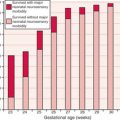CHAPTER 19 Cranial ultrasounds
Findings
Intraventricular haemorrhage (IVH)
| Grade | Features |
|---|---|
| 1 | Germinal matrix or sub-ependymal bleed, no intraventricular blood |
| 2 | Grade 1 plus intraventricular blood, no ventricular dilatation |
| 3 | Grade 2 plus ventricular dilatation |
| 4 | Grade 3 plus haemorrhage in the periventricular area |
A Grade 4 bleed is not an extension of a Grade 3 bleed. It is probably a haemorrhagic–ischaemic lesion secondary to venous congestion (venous infarction) in the periventricular region due to the germinal matrix bleed.
Periventricular echogenicity (PVE)
Outcomes
Table 19.1 on page 118 summarises the outcomes for various cranial US findings.
• Most studies report results from routine ultrasounds done on infants either < ∼1500 g birthweight or < ∼32–34 weeks GA.
• The studies usually report CP/disability rates in survivors. However, they all report different outcomes that will mean different things.
• Numbers in the ‘Outcome’ column are either from individual studies or a conglomeration of studies.
Table 19.1 Outcomes for various cranial ultrasound (US) findings in populations of high-risk infants (as detailed in text)
| US finding | Outcome |
| Normal | 5–8% have significant motor deficit, IQ <70, and/or moderate/severe disability |
| Intraventricular haemorrhage, IVH | |
| 1 | 4–5% severe disability |
| 2 | 10–15% severe disability |
| 3 | 20–35% CP/intellectual deficit |
| 4, all | ∼50–70% CP/intellectual deficit/IQ <70; 30–60% will need VP shunt |
| 4 + cysts | 80% moderate/severe disability; 90+% CP |
| Periventricular echogenicity, PVE (no cysts) | |
| <7 days | as for normal scan |
| 7–21 days | 6–8% CP ±intellectual deficit |
| >21 days | >80% some neurological abnormality/CP |
| Periventricular leucomalacia, PVL | |
| All | 50–60% moderate/severe disability; 50–100% CP |
| Unilateral | 40–50% CP |
| Bilateral | 85–95% CP |
| Focal | 50–60% CP |
| Extensive | >95% CP |
| Small | 60–70% CP |
| Large | >90% CP |
| Ventriculomegaly | |
| PHVD | 25–35% moderate/severe disability |
| 50–60% need VP shunt | |
| Ventriculomegaly at term | 45–55% IQ <70; 40–50% CP |
| Hydrocephalus | 50–60% moderate/severe disability |
| 50–60% need VP shunt | |
| Shunted | 40–60% moderate/severe disability |
CP = cerebral palsy; IQ = intelligence quotient;
PHVD = post-haemorrhagic ventricular dilatation;
VP = ventriculo-peritoneal.




